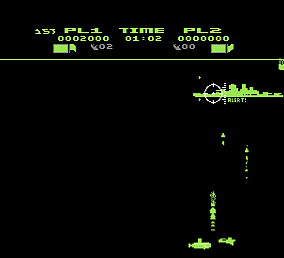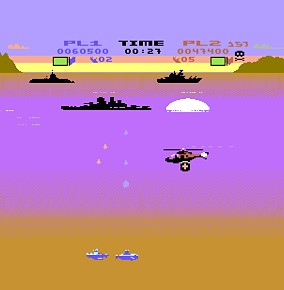Make the C64 Great Again with Seawolves & Parallaxian!
Kodiak64 News
Two New Technical Articles on 6502 Coding on the C64
Posted on 22-July-2025 by Kodiak
There are now two new* technical articles uploaded for coders to look at.
The first one is 9 Exotic Coding Tricks used in the C64 Game, Seawolves and
covers some of the perhaps unusual technical features that make the game possible.
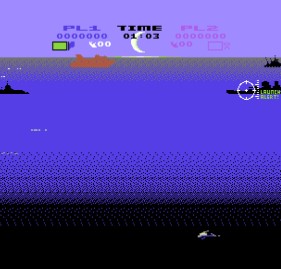
The second article is one I had been planning on writing for several years but just never got round to until recently.
It is How to Set Up and Use NMIs On the Commodore 64 and fills (I hope!) a gap
in the C64 coding scene's documentation on the subject, since it is a very badly explained** and, perhaps consequently, generally ignored topic.
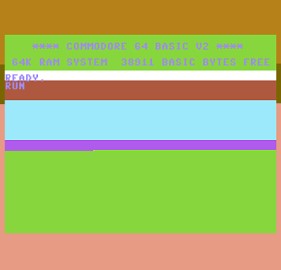
(* The first article, albeit in a lesser form, was previously released on my website last year before it went down with my old web host, but this is a new version of it
with extra content).
(** If you want a compendium of atrociously explained, assumption-laden and poorly laid-out coding articles, check out most of the materials on Codebase64).
Sales Figures for Seawolves on the Commodore 64
Posted on 09-July-2025 by Kodiak
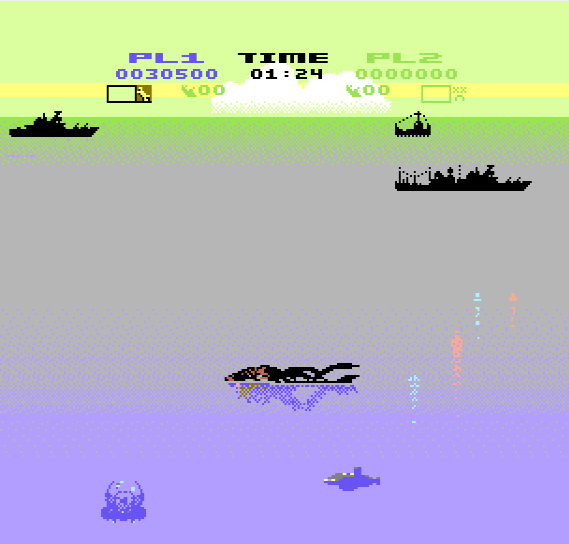
I have often wondered about the true level of digital download sales for commercial games on the Commodore 64 in the scene’s present middle-aged
consumer market, and if you are an aspiring C64 games developer, you might very well be wondering the same.
Of course, when I say “middle-aged”, there is a subtle inference or subtext suggesting that, in theory at least, these are not penniless
teenagers who must resort to piracy to get their hands on the latest “wares”.
No, I am presuming that most of them have had their financial “ducks in a row” for a long time by now and can therefore afford to indulge in a bit of
retro nostalgia.
And sure, I know that statistically there must be some old sceners who are broke, but one tends to (or likes to) imagine that such are merely outliers
unrepresentative of the scene as a whole.
So with that sweeping assumption laid down right at the start, I come to disclose and review the sales figures for my first ever
new Commodore 64 game release,
Seawolves,
which was unleashed in March 2024, albeit only in a digital format.
Would you like to hazard a guess?
What would you think the sales levels would be of a very positively reviewed game that took approximately 15 months to develop, using some pretty
exotic coding tricks and endless play testing and fine-tuning?
400 copies?
300?
200?
All wrong.
Try just over one hundred sales in the space of 15 months.
Yes, you read that right.
The customer list is just over 110, with the greater bulk of them loaded into the first 3-4 months.
Early Promotional Efforts + Buyer Demographics
I used my YouTube channel to spread the news, as well as my own website (before my appalling web host, tsohost, vanished from the face of the earth and
took kodiak64.com with it).
Favourable reviews quickly followed from
Retro Gamer Nation and
BastichB
(although he omitted it from his list of top 10 games for 2024), and it was on the crest of the ensuing waves that most of my sales
came.
By far, most of the sales came from Germany, followed by the UK.
Understandably, very few in the US bought the game, given that it is PAL-only.
Why No itch.io Presence?
I made a conscious decision not to use itch.io to sell the game because, as a matter of principle, I did not and still do not agree with their sign-up
terms.
Some have decried that as a mistake that has harmed my sales, and it may indeed be true that it has hampered sales, but not as much as piracy has.
Instead I have confined sales to my own platform which, as alluded to earlier, was offline for a period – I think 2-3 months – in the aftermath of my
web host debacle, and during that period two or three people privately asked to buy the game.
In all, I estimate the game raised somewhere between £700 and £800 in sales (as some very generous people paid far more than the asking price),
so one would be clinically insane to imagine it was a success.
In fact, I would say that unless I release the proposed enhanced cartridge version of the game, it has been a grade A waste of effort.
Lessons for Parallaxian
In many respects I saw Seawolves as a pathfinder for the planned Parallaxian release.
It helped me refine my own concept of what makes a game playable and addictive, shifting my natural focus on impressive effects away to gameplay instead,
although I now insist that both are equally important, as opposed to my previous fixation on emphasising effects.
I also was keen to see how my enemies in the scene would react, but they largely ignored Seawolves, possibly due to the effusive praise the game was
receiving.
That said, I knew they would not forget Parallaxian, as the
December fiasco proved when it smoked out you-know-who.
One of the biggest lessons, however, that Seawolves taught me was the folly of digital releases.
Since the well-heeled middle aged scene (as I imagine it to be at least!) is still acting like spotty teenagers freely pirating digital content,
the only path open to me for releasing Parallaxian is cartridge, and yes, I have asserted this before, but here I will do so again: there will
NEVER be a digital release of Parallaxian, so if anyone wants to play it, they will have to use real hardware or else have access to a buyer of the
cartridge willing and able to illegally copy it into a digital format.
Closing Thoughts
Overall then, my experience with developing Seawolves has been demoralising and demotivating to say the least, but was not entirely unexpected.
I am still working hard on Parallaxian and if it gets finished, boy oh boy, what a game it will be!
But it will also be my last attempt at any kind of “AAA” game on the C64, which means I am saying
Deep Winter is hereby formally cancelled...
To be fair, the total lack of encouraging feedback from those I sent early tech demos to had already decided that anyway.
Nevertheless, I would like to think I will carry on coding to keep my brain sharp even after Parallaxian, but only on minor projects, such as
the planned Seawolves II game.
As for professional game development on the C64, I would strongly counsel anyone thinking about it to look for something far more productive
instead and just let the shovelware keep on flowing to feed to the crackers until the scene finally peters out.
But that’s just my opinion, obviously.
Kodiak.
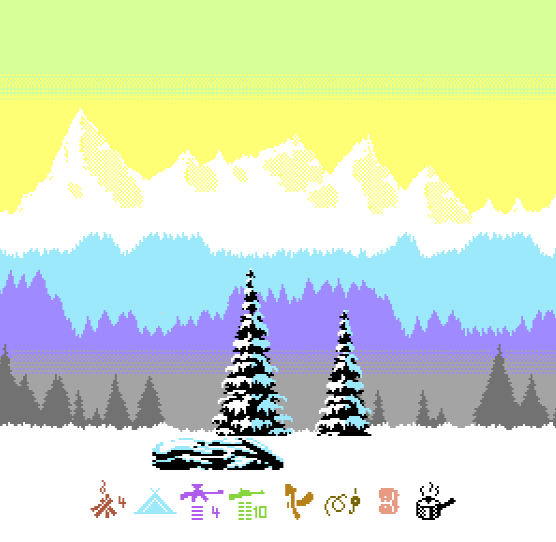
Parallaxian WIP June 2025
Posted on 02-June-2025 by Kodiak
Parallaxian WIP Update June 2025
June25.png)
This is a redacted WIP update as I do not want anyone outside my trusted circle of C64 scene contacts to know the real extent of progress on
Parallaxian at this stage.
Accordingly, all I want to disclose for now are some design updates to the main sprite to freshen it up in the wake of the disgraceful and
unauthorised release on CSDB of an old, stale tech demo in December.
The original 1995 design was composed of two multicolour sprites but in 2018 I updated that to the design everyone has been used to in my WIP
coverage on this website and on YouTube;
that design was made up of a hi-res silhouette for the main fuselage and tail, with a multicolour sprite for the cockpit and nose section.
The 2018 version very much retained the 1990s vibe of the original design, which was obviously inspired by the gorgeous curves of the two-seater variants
of the Russian Sukhoi Su-27 Flanker
series of fighter jets entering service in the Russian air force at that time.
Sharp readers might also notice that the name "Figment" follows the NATO tradition of assigning reporting names starting with the letter "F" for Russian
fighter aircraft, not that I intend the plane in Parallaxian to be at all Russian!
Below are some new design iterations developed over the past few weeks, mostly done when I was too tired to code.
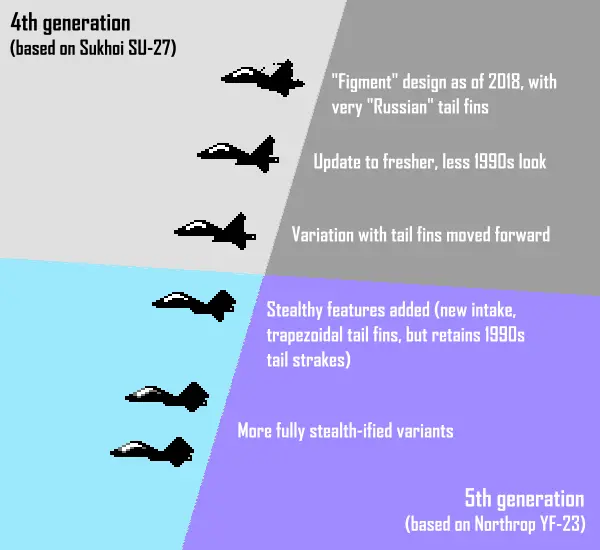
Let me know your thoughts
Of the 4th-gen designs, my personal favourite is the third one and at the moment I am torn between using it and one of the latter two stealth variants
in the finished game, but I would welcome feedback from my readers by email (jon 'at' kodiak64.co.uk) on what you think is the best design.
Other progress...
I have spent most of the past 4-5 weeks on two new planet designs, one of which features extensive use of ECBM graphics and the other with some bitmap.
Both of these new planets display a slightly altered perspective; the first one also has some interesting special backdrops that would certainly catch the eye!
However, as I trust you understand, I am being very protective of the game in the wake of the December debacle and the attacks made against it by its original hater,
so please be patient with me as I continue this marathon project.
Oops! Plus a Parallaxian WIP Update
Posted on 01-April-2025 by Kodiak
Oops!
In my previous update I tried to extinguish some of the fires started by the unsanctioned release of a technical testbed of
Parallaxian, but I carelessly made a couple of blunders.
First of all, I said that the culprit, PCOLLINS, was a member of Excess but it turns out he had left them by that stage and is now part of the
Quantum cracking group, so I have apologised to Excess and corrected the mistake in the article accordingly.
Perhaps worse, however, I rushed to provide a code snippet from the Parallaxian demo showing the FLD method I was using in the tech demo, given that You-Know-Who had taken aim at it
in one of his numerous diatribes against the game as part of his neverending quest to discredit the project.
In my haste I didn't properly read what I was saying about my own code and, consequently, didn't properly count the cycles for a fully expanded FLD deployment, presenting him with a
gift-wrapped opportunity to savage what I had written. This was an opportunity he gladly seized, from what I have been told, and no wonder, given that I provoked him by impulsively pointing
out daft things he had said online in the C64 scene (which I should not have done).
So yes, I was sloppy in my previous article and he called me out on it. LESSON: Don't be in a rush to prove a point, especially involving someone so passionately disdainful of you.
However, I would remind him that WayBackMachine exists and anyone could go back to Codebase.org and forensically pick apart his old contributions there.
Back to Parallaxian
For the past 6-7 weeks I have been working flat-out most days on the game in a grand bid to get it finished before WW3 comes.
Due to the unsanctioned tech demo release in December, I have made many changes and ripped out huge swathes of code, removing things that add nothing to the game and replacing them
with things focussed on producing better gameplay, for which policy I have the development of Seawolves to largely thank.
Without going into too many details, this is a list of what has been done since the last update:
- Panel zone redesigned and refined further, mostly to reflect the search-and-rescue aspects of the game gameplay.
- The new fuel and damage gauges have been designed, with the former now fully functional.
- The central shields indicator has been shrunk into a compact square and its new purpose (as far its colours go) is to let the player know when a colonist is below waiting to be picked up, and also when / where it is safe to land.
- A low level terrain-avoidance warning system has been added, as some levels have substantial obstacles that must not be crashed into.
- A new lives-remaining indicator.
- Satellite dish repair indicators - each level has 3 such dishes in need of repair and the player must locate engineers to ferry to those satellite dishes to conduct said work!
- A passenger indicator showing which kind of colonist, if any, is currently aboard the plane.
- A lock-on indicator (not yet functional) for when enemy homing missiles engage the plane.
- Some substantial redesign of the desertscape to freshen it up.
- A massive refactoring of the feed-in + scroll code for sprite objects littered around the landscape, with a new facility enabling "tall" or "stacked" objects.
- A totally new shadow generator.
- Some minor but noticeable redesign of the home base, most notably the addition of a tall radio mast.
- A complete redesign of the Hunter-Killer, as the original was too blocky and required too many sprite frames to animate.
Hunter Killer V.2.0.
Yes, the old design was (a) stale, (b) too blocky, (c) too tall, (d) consumed too many frames and (e) not "droney" enough, so I took some inspiration from the nasty drones in the
Tom Cruise film, Oblivion, for the redesign.
The image below shows the different variations I tried out in Photoshopped snaps of different game worlds en route to settling on the
favoured new design.
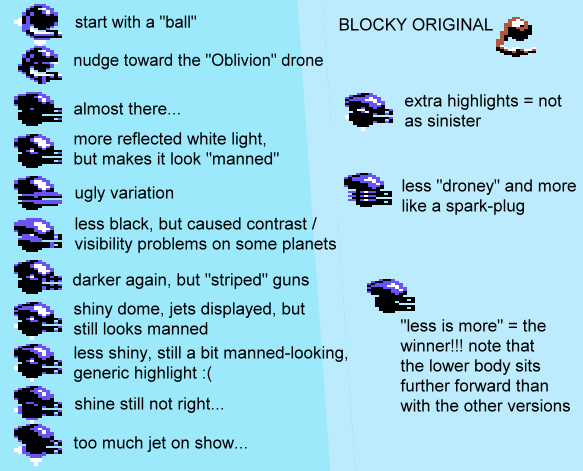
Will I redesign any other major sprites?
Maybe, but only if it adds to the gaming experience or freshens things up.
Obviously the prime candidate for that would be the player's plane, i.e., the Figment itself. After all, when I first designed it back in 1995, Flankers were all the rage but nowadays it's the sixth-gen
stealth vibe that's red hot.
Any WIP Videos?
After the damage done by the December debacle, I am in no mood to publicise the game before the eve of its release, and so I maintain my stance that there will be no more previews emailed out and
no WIP videos to further soften the impact of the game.
Parallaxian 'Cancellation' (Fake News)
Posted on 11-February-2025 by Kodiak
In late December 2024, it came to my attention that someone had declared to the Commodore 64 scene that my game,
Parallaxian, had been cancelled and the news was quickly relayed by IndieRetroNews without first
consulting me (although they very graciously withdrew the article when I complained about it).
Backing the false news up, the person who did this took a technical demo of the game that I had privately sent him and
released it on CSDB, as a “Christmas gift” to the scene.
That person was a scener called "PCOLLINS", whom I had naively trusted as a play-tester for Seawolves,
my first C64 game release.
Of course, when I had sent him what is now a very old and outdated Parallaxian tech demo, I had no idea he was actually a cracker associated with the QUANTUM
cracking group (previously, I had mistakenly asserted he was a member of Excess, but they contacted me to explain that he is not and that they do not condone what he did at all,
and on the contrary, have a respectful attitude towards commercial games, so this is my public apology to Excess).
As a consequence of this, I have made the decision to make no more digital releases for the C64 beyond Seawolves.
Enter my Stalker
This turn of events was instantly and gleefully seized upon by a very unpleasant and argumentative know-it-all persona within the scene who has passionately
hated both Parallaxian and me from the beginning, having tried to sabotage its Kickstarter campaign back in 2018 by viciously attacking me and attempting to have me
“cancelled” for
opposing his hysterical far-left views supporting the LGBT agenda and the degenerate filth of unfathomably evil "trans people" aka demonic monsters
(views which,
for the record as a conservative Christian, I unapologetically find utterly vile and abominable).
Meanwhile, his hatred of Parallaxian seems to come from an exaggerated interpretation of my statements about the game back when I first made it known it was under development.
Consider the following:
- I said that Parallaxian was unusual in that it used both NMIs and IRQs at the same time; he has reframed this to say that I was claiming that mine was the first or only game to ever do so, a claim I simply never made. He further added that there are many games that do this, though so far I only know of the Samurai Rabbit game (and my own Seawolves and the chase level I coded for Hend’s The Wild Wood), although I am sure there are a few other rare examples out there.
- I said Parallaxian made use of a technique I arbitrarily called “toggle-plexing” and that LuftrauzerZ was an example of a game that had done the same thing before I did; he twisted my words to say that I was claiming that Parallaxian was the first to do this, when not only did I say no such thing, but went to lengths to say the opposite!
- I said that Parallaxian was the first C64 game to have parallaxed vertical-within-horizontal scrolling; it transpires (allegedly) that he made a crude prototype of something extremely ugly and blocky back in the mists of time, albeit his was (a) an incomplete effect with large black gaps appearing between the horizontal scroll layers and (b) the subject of some controversy when for a long period of forum back-and-forths over on Lemon64 the tape / disk of it had vanished and he was only able to “prove” he had done it after finding said long lost tape / disk (or, as some cynically speculated, hastily coded it to make it appear like he had dug it out of his attic). My point is that an incomplete effect is not a "scene first", just as Leonardo da Vinci's 'helicopter' sketches did not constitute the first example of a viable rotorcraft!!! UPDATE: He has now finished his eyesore of a "game" and is proudly and loudly proclaiming it as the first to have vertical-within-horizontal parallax scrolling, and he has gone further and drawn attention to it using NMIs combined with IRQs, you know, the same thing I originally mentioned was a feature of Parallaxian and Seawolves in my efforts to market my games. I will leave the reader to draw his own conclusions.
- I said Parallaxian used only a little FLD in implementing the verticality of the parallax scrolling, whereas it seems he has tried to allege I used it more than that and did so with a shoddy implementation of FLD, thereby casting aspersions on my abilities as a coder (I will let the reader judge for himself my credentials in that regard – the actual techniques are covered further below).
- I said that even the Amiga had no games with the vertical-within-horizontal parallax effect, but was since proven wrong and am happy to admit I was wrong. Oddly, I don’t think my enemy took issue with me on that one, but I mention it now for completeness.
- In addition to all of the above, he has accused me of misrepresenting his sexuality, despite no written record of me ever making any such assertion; on the contrary, some who have privately made that suggestion have been met by a firm contradiction from me. Despicable though I find him and his values, I am not going to have him slandered for being something I have no grounds to believe he is.
He further crowed that "the game is dull"...
My reply is WHAT GAME?
A tech demo is not a game. It's a tech demo. That's why it is called a "tech demo" and not a "game".
Then again, he thinks his ugly, unfinished project from decades ago is "the first game to have such an effect", so that proves beyond dispute how twisted his logic is.
With that all said, I don’t need to further belabour any points. He is a demonstrably odious character with a victim complex who appears to seek confrontation not
just within the C64 scene but
across multiple domains, while at the same time showing a pathological need for adulation, so I am sure he will carry on twisting my words and rewriting the past to
suit his narrative - when he's not busy stirring up trouble elsewhere, that is.
Accordingly, at this juncture I think it would be wise to let this be my last word on his vendetta for now, although I fully expect he plans to go on another rampage against me
when Parallaxian is released. Sadly for him, he has bigger problems in his life to worry about than trying to attack me; like the rest of us, he desperately needs Christ.
How is Parallaxian’s Vertical-within-Horizontal Scrolling Really Done?
The screenshot below shows the different vertical parallax zones used to make the effect work:
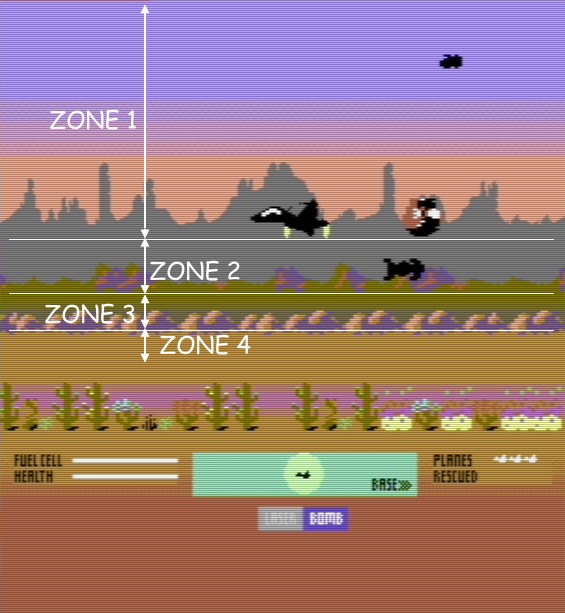
- ZONE 1: A plain old un-sync’ed write to Y-SCROLL on $D011. This is not FLD, although I have reason to suspect my critic imagines it to be some attempt at crude FLD execution on my part.
- ZONE 2: The same is done for the 2nd layer of vertical scrolling, albeit with the raster line it happens on also being adjusted.
- ZONE 3: The most complicated is the 3rd layer, which adjusts raster line and grabs vertically adjusted gfx (i.e., each vertical position uses its own little block char definitions). What it does not do is FLD or in any fashion touch Y-SCROLL on $D011.
- ZONE 4: The final layer adjusts 2 raster trigger points (one for the colour-setting, one for the rest of the effect) and is the only FLD layer. The “shoddy” code for its FLD element is here:
| ; FLD preparation | ||
| ; | ||
| LAX $D012 | ; (3 bytes) | |
| FLD_SBX | SBX #00 | ; (2 bytes) <<< SELF-MODIFIED |
| STX FLD_WAIT+1 | ; (3 bytes) | |
| TAX | ; (1 byte) | |
| ; Actual FLD routine | ||
| ; | ||
| FLD_LOOP | DEX | ; [2 cyc] (1 byte) |
| TXA | ; [2 cyc] (1 byte) | |
| AND #%00000111 | ; [2 cyc] (2 bytes) | |
| ORA #%00011000 | ; [2 cyc] (2 bytes) | |
| STA $D011 | ; [4 cyc] (3 bytes) | |
| LDX $D012 | ; [4 cyc] (3 bytes) | |
| FLD_WAIT | CPX #00 | ; [2 cyc] (2 bytes) <<< SELF-MODIFIED by FLD preparation above |
| BNE FLD_LOOP | ; [2* cyc] (2 bytes) |
If you are an experienced coder, you will see that it is an extremely lightweight and efficient implementation of FLD.
UPDATE You-Know-Who released a video disproving that assertion, and I address that (and my underlying faux pas) in
this article.
Ultimately, however, who cares? As long as the game works, that's what should matter.
Okay, so how is Progress with Parallaxian now?
S-l-o-w.
After I released Seawolves, I started a new job that consumed unhealthy amounts of my time as well as draining me mentally and physically. That meant I was pinned down and, given that I have a family as well, I was left with very little time other than Saturday afternoons to advance Parallaxian.
That said, I have since moved on and will hopefully have a little more time each week to work on the game, just not as much as I had for Seawolves.
The major items of progress I made since my last update are:
- The total overhaul of the low speed handling characteristics of the plane, which mean it now feels much more natural when trying to carefully land it. This was torture to get right and took months of endless rewrites of the relevant code before I was happy with it.
- A totally redesigned panel zone, with a new fuel gauge, a damage gauge, a G-LOC indicator, a laser temperature gauge, a missile lock-on warning system, and a score feature. Yes, I finally caved in and decided to add a scoreboard (not shown in the mock-up image below).
- A redesigned Hunter-Killer, to freshen things up after that despicable release of my tech demo in December.
- Several new worlds / scenes. The game was originally have 5 levels but now I am aiming for 6.
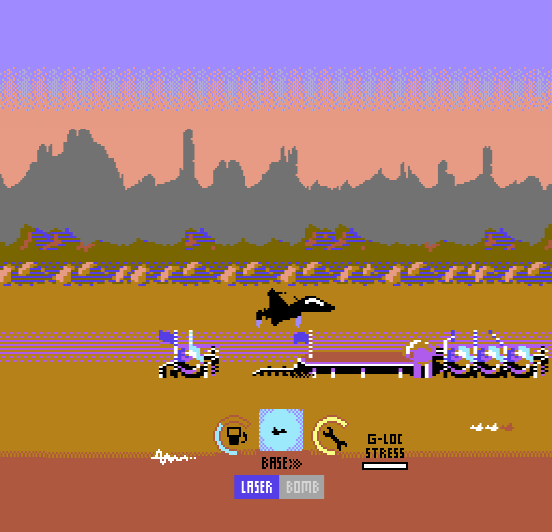
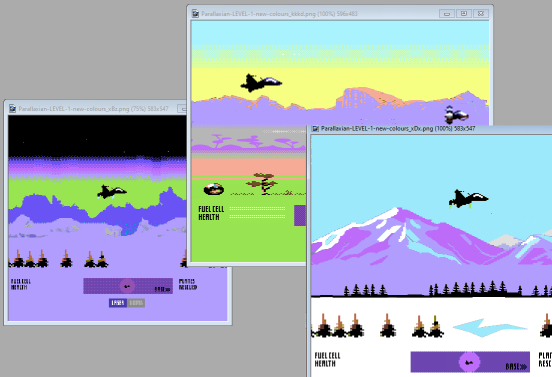
The only place you can see these updates is this website, so please check in every so often.
Closing Thoughts on the Fake News of December
With half the scene (or more) having now been exposed to Parallaxian's tech demo, the unsanctioned CSDB leak has robbed those who might eventually buy the game of the
thrill of seeing it in action on their own machines for the first time.
The person who did this - PCOLLINS - should be hounded from the scene for what he has done.
But guess what?
He has been playing the same little trick with other game coders, one of whom showed me what he was up to; thankfully, the coder concerned ghosted him.
Of course, I understand what happened with that unsanctioned tech demo release.
He saw that my website was down, my email was down and could not resist the temptation to score some kudos by uploading the tech demo to CSDB in
what was an extremely rude and selfish act.
This has solidified my resolve, however, to never again release any of my games in a digital format. Parallaxian can only be sold as a cartridge, on a limited edition basis,
and on a right-to-refuse-to-sell-to-certain-people basis.
Seawolves, too, will hopefully have a cartridge release, and for now I am going to allow the updated digital version to be sold here on this website.
However, I might suspend it at any moment, so move fast if you want to buy it.
And yes, when you buy it and don’t distribute it to your mates, you constructively support C64 game development. That stands in stark contrast to those bottom-feeders
who share games and spread their lame cracked versions for three seconds of “glory” on CSDB. We’re not teenagers any more fellas, we’re all middle-aged or close thereto
and can afford a paltry few quid for a game, surely?
But I know that will fall on deaf ears so... When the lights finally go out for real on the C64 game dev scene, maybe you crackers could, for the first time in your
pathetic “careers”, apply your coding skills to making some games yourselves, because you’ll be the last ones standing at that stage.
This Kodiak, signing off.
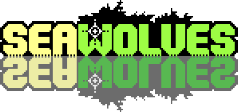
"...a great game, with smooth controls and high replay value." (Review on Lemon64).
"It could be a modern classic..." (BastichB Review on YouTube).
"Absolutely fantastic re-imagining of the classic Sea Wolf. It dials everything up to 11, the control, the feel and gameplay nuances all make the game stand out.
I would really put this game in my top ten of all time it's that good." (Review on Lemon64).

